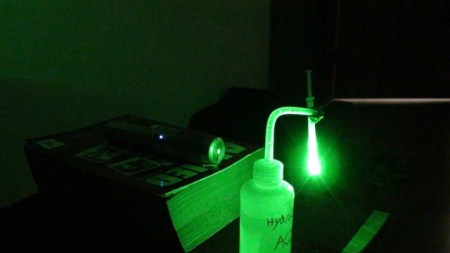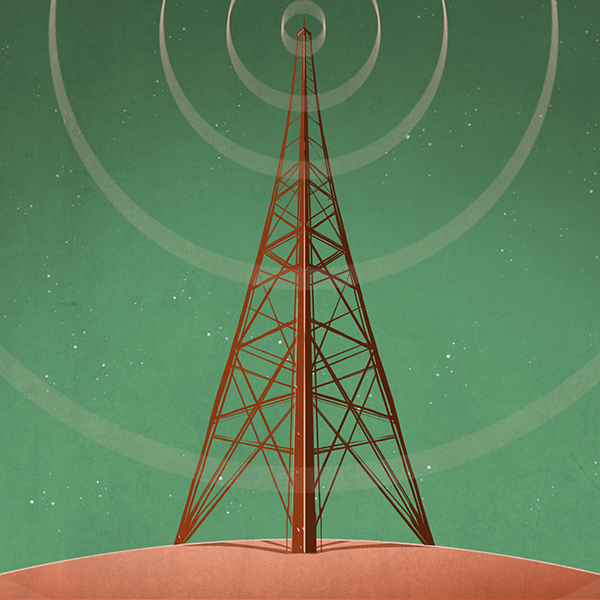
Ok, we’ll start this off by saying, looking at lasers can damage your eyes. Be careful. Now that we’ve got that absolutely clear, we couldn’t help but find this super quick and dirty laser microscope fascinating. Basically, they are just pointing a laser through a drop of water suspended from the tip of a syringe. The image of the contents of the drop are projected on a nearby wall. The drop seen in the video after the break was taken from a potted plant and you can see all kinds of life squirming around in there. Just don’t try it with this laser.
[via HackedGadgets]
[youtube=http://www.youtube.com/watch?v=2aK_a-jr-tI]
















cool
That is awesome! I will be trying this with my <30mW green laser :D
http://www.youtube.com/watch?v=rWYeA46cvL8
Better explanation (Arbor scientific: http://www.arborsci.com/)
i did that few years ago with my 200mw DX red laser. just remove the lens, attach thin nice clean glass top of it then put the sample. voila!
Why is that cat not wearing protective goggles?! OMG!
Thats amazing – there seems to be a microscopic cat in the water droplet! I bet a conventional microscope would’ve missed that…
Wow, You found my website! It’s not done yet :/
first off, that is very awesome!
second, my favorite part of the video is the cat.
Patent it, put it in a self contained box and sell it as a natural light show for clubs.
yay, another 4hv’er gets on hackaday :-)
wonder what would happen if you used a sequentially pulsed RGV laser for this? would be really neat and potentially very useful for on-the-cheap viewing of microorganisms without a bulky microscope..
i’d expect that the violet light would stimulate fluorescence in the organisms showing some internal structures..
one thing which lasers are good at is pulsing very rapidly, such that an electronic optical blanking system which blocks out the laser pulses but allows everything else through would show any fluorescence. Kinda like CSI:Laser
@zeropointmodule
You wouldn’t see the flourescence as that wouldn’t effect the laser beam. Under a conventional microscope yes… but not on a projector.
OMG! You found the elusive MicroCat! I’ve been studying microorganisms for years searching for it, and you found it in a potted plant sample!?
The image projected depends on the wavelength of light so an RGB hack may not work well with a long distance to the wall from the sample. It’s called diffraction.
Could this be used as a DIY solution to see if water is safe to drink?
@Hackius Would be cheaper to use the microscope the old fashion way to look at the water sample, eyeball to the eye piece. Assuming one knows what they are looking for, could recognize it when they see it.
this has been known but still pretty cool
that cat is a scientist
Damn It. I got RickRolled on that site.
Nice hack btw!
ALL HAIL LASERCAT
I wonder if this should be filed under cat toys or cat entertainment. That cat really seemed to get into this.
Brilliant.
@Hackius, Last time I checked, lead and arsenic don’t move. Also, if you checked your tap water, you’d probably find a few things swimming around in there.
Hey way cool But FYI, those are NOT bacteria. They are
Protozoans. Cilliates by the way they move, about 50 times bigger than most bacteria. A classic hs ciliate is the amazing
Paramecium, looks like you and your cat are spying on about
Twenty of them………. I can’t wait to try this….. Thanks
Best tefman
Really cool, but i’d like to point out that looks like a pretty mean handheld laser device and not just a $5 laser pointer.
i’ll never drink water again
My science teacher is so lame… -_-
Whoa that is freakishly good stuff.
@Dan Fruzzetti
The Website states, that it’s a 250mW Laser…
So yes. It’s not a $5 Laserpointer :)
I watched the video and immediately grabbed my cheap regular red laser pointer and tried it out. This works!
Now, I know that my drinking water has more stuff swimming in it than my tap water. Also, my eyes feel really weird after looking at the projected image. Do I need any type of goggles when looking at projections made by those common cheapo toy red laser pointers?
As a high school biology teacher, I think I can *definitely* use this idea!! I love it. I have a nice, hefty laser donated to me by a university instructor (red, not green… it shouldn’t matter too much).
But just to be clear: This is just a laser shining through a hanging drop of water, right? It’s nothing more than the refraction of light through water and the geometry of the drop that causes the full-wall (and partial ceiling) display. Is that correct?
Also, with the laser being diffused that much due to all that diffraction, how much danger is there looking toward the display? (Obviosly not toward the laser source.)
^^^
Not much danger.
I spend a lot of time swimming laps at night, and what I’m about to tell you has happened to me twice. Basically, I was not using goggles, and I got some drops of water on my eyelashes in such a way that I could see strangely-shaped animated forms moving about and swimming across my vision. They looked much like the ones in the video, but I could only see them if I angled my head just right in relation to the bright lights pointed on the pool from a nearby building. This confirms the possibility of water magnifying something so small and making it visible with just a drop and a light source. Very interesting Thanks!
Old microbiologist above writes about ..
http://en.wikipedia.org/wiki/Protozoa
“The most important protozoans range usually from 10 to 52 micrometers, but can grow as large as 1 mm, and are seen easily by microscope.”
Cilliates (about 50 times bigger than most bacteria)
http://en.wikipedia.org/wiki/Ciliate
http://en.wikipedia.org/wiki/Paramecium
As a male, I was wondering if 1 µm could be achieved to have a look at http://en.wikipedia.org/wiki/Spermatozoon
“In male humans, sperm cells consists of a head 5 µm by 3 µm and a tail 41 µm long.”
Here’s someone who shines a focused beam through semen:
Transmission Interferogram of Seminal Fluid:
http://www.youtube.com/watch?v=ewWhc2gw6rg
Related, here is another approach to a laser projection microscope: http://hackaday.com/2011/03/02/a-different-take-on-a-laser-projection-microscope
This isn’t news to anyone with strong myopia – what you’re seeing projected on the wall is what we see with glasses removed when looking at a point source of light against a dark background.
Yes, there are all kinds of weird stuff floating around on the surface of your eyeballs.
No kidding. Here’s to taking off the old spectacles for any surface-mount soldering, too!
If you are a bit of a software programmer and photographer, you can photograph the image and use a software algorithm to filter the moire pattern and focus on any depth of the image. In essence what you are projecting using this cool experiment action is a flat hologram. I remember searching the Internet once to see if a DSLR camera can capture holograms using a laser and came across an article of an experiment done by a University student. Unfortunately I cannot find a reference to it right now except for this link
https://www.google.com.au/url?sa=t&rct=j&q=&esrc=s&source=web&cd=10&cad=rja&uact=8&ved=2ahUKEwi2ttOg76PhAhXYXCsKHRO9CzEQFjAJegQIABAC&url=https%3A%2F%2Fme.jhu.edu%2Flefd%2Fshc%2FLPholo%2FDigital%2520Holography%2520using%2520a%2520Laser%2520Pointer%2520and%2520Consumer%2520Digital%2520Camera.pdf&usg=AOvVaw0yBz15y6_j7yytu1P7JHwB
I tried contacting the guy to get the software, however he does not respond to emails at the address provided. If anyone has the software, please post a link here.